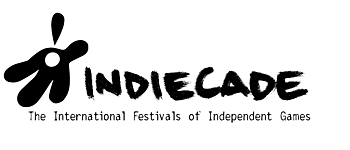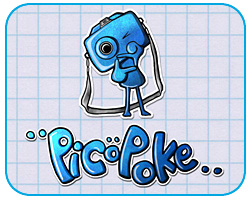|
|
In which our hero checks in very briefly to share a lovely German sunrise with you.
As I mentioned in an earlier post, I’ve somehow managed to get myself into a situation where I’m attending three conferences in two weeks, and presenting at two of them. The first one is starting now, which is why I’m posting this from Berlin, Germany (!!), which is hosting the third Pictoplasma conference. Since people seemed to like my videoblogging from Singapore back in December, I’ve decided to give it another go. So now, without further ado… (Apologies to those reading this in RSS feeds that don’t include video feeds -Â you’ll have to check out the videos over at http://www.geoffreylong.com/journal.)
In which our hero introduces CONATHON09 and waits on a plane.


I’ve just realized, much to my horror, that it’s been almost a month since I’ve posted anything here. Yikes. Sorry about that – suffice it to say that the last couple of weeks have been even more intense than usual, and the next couple of weeks are going to be even more intense than that. My lack of posting any new content here is Not Good, since I hope I’m going to be getting at least a few new visitors to this site after the smoke has cleared from the next two weeks. Let me explain.
On Tuesday, the GAMBIT Review Committee is showing up to go over our lab’s progress as we near the halfway point of our initial five-year mission. The goal here is to overwhelm them (shock and awe, shock and awe!) with our excellence, so much so that the report they generate and send back to our funders in Singapore will result in a renewal of our funding, thus making our five-year mission a ten-or-more-year mission. To say this is a Very Big Deal is a fairly large understatement. As a result, I’ve been up to my neck in slides for the last week or so, hammering out the big presentation that’s scheduled to go down on Tuesday morning.
Unfortunately, I don’t get to stay around for the whole thing. As has been reported by several websites, on Tuesday afternoon I’m boarding an international flight to Germany, where I’ll be presenting a lecture on character design for transmedia franchises at the 3rd Pictoplasma Conference in Berlin, which I’m intensely excited about despite the fact that I speak no German. This should be interesting, to say the least. With a little luck I’ll be able to post videoblog entries like I did on my trip to Singapore last year, and I’ll post my slides and lecture notes over on my Presentations and Lectures page sometime before the end of the month. Here’s the basic synopsis of my talk:
From Plot to Character to World: Some Aesthetics of Transmedia Storytelling
As transmedia franchises such as Star Wars, Buffy the Vampire Slayer, LOST and Heroes increase in popularity, the ability to create characters that audiences will follow from one media form to the next becomes absolutely critical. Attendees will be shown how such carefully-crafted characters are the key to the success of such transmedia storytellers as George Lucas, Joss Whedon, J.J. Abrams, Jim Henson and Tim Kring. By drawing on the theories of Henry Jenkins, Stephen King and John Keats, this talk will examine such key aesthetics of transmedia franchises as the skillful deployment of negative capability and the shift in narrative emphasis from plot to character to world.
So I get to see a little bit of Berlin while I’m there, then I’m flying from Germany back to San Francisco, where I’ll be attending the 2009 Game Developers Conference until Thursday evening, when I’m hopping another plane to come jetting back to Boston to present at the 2009 American Comparative Literature Association conference at Harvard. Here’s the abstract for that talk:
From Horrorism to Terrorism: the New Weird, the New Horror and the War on Terror
On Halloween 2008, the fantasy and science fiction author Jo Walton posted an entry called “Halloween Special: Why I hate horror” to Tor.com, in which she declared: “…What horror readers want is blood, right away, rivers of it, and scary stuff too, immediately, even before you care about the characters.” In the comments to her post, the novelist and essayist Nick Mamatas snarkily quoted this passage with the retort, “Ah, now I know! I also look forward to future posts in which I am told what I like in a meal, and in a sexual partner.”
This exchange exemplifies the current shifting perceptions within and without of the horror genre. In the foreword to his 2008 anthology Poe’s Children: The New Horror, horror novelist Peter Straub describes a new current horror Renaissance led by authors such as Kelly Link, who have more in common with John Crowley and Jonathan Carroll than with the authors who made up the previous horror boom in the 1970s and 1980s. What separates these generations is a shift away from horror and towards terror, as the terms are described in John Clute’s 2005 short lexicon of horror, The Darkening Garden: terror is the revelation that the characters’ normal, reliable world does not always adhere to the normal, reliable rules and actually has more wondrous and threatening creatures, places and things in it than one had imagined; horror, on the other hand, is when those threatening new elements actually make good on their threats and rend the characters limb from limb. Under these criteria, terror stories are more psychological and horror is more visceral.
It doesn’t take much of a leap to connect the rise of this new psychological type of terror story to the popular mindset and psychology of America (and indeed the world) after 9/11. Terrorist warfare relies on the same basic mental mechanics as terror stories – both rip away our basic assumptions of safety and rely on the negative capability of the human imagination to do the rest; arguably, both are the most effective when the actual horror (the bombs, the dismemberment) never comes. This may be why the 2000s have seen not only the rise of Straub’s New Horror but also the rise of the New Weird, as described by Jeff and Ann Vandermeer in their co-edited 2007 anthology of the same name, and the rebirth of the classic Weird Tales magazine under the editorship of Stephen H. Segal. Storytellers working under the banner of either the New Horror or the New Weird frequently have much more in common with H.P. Lovecraft’s cosmic horrors than with the splatterfests of the 1970s and 1980s, which includes not only authors but also filmmakers and graphic novelists as well, as evidenced by the recent popularity of Guillermo del Toro’s Pan’s Labyrinth and Mike Mignola’s Hellboy.
This paper will drill deeper into these observations, pulling examples from fiction, film and comics. It will compare the characteristics of Straub’s New Horror to the Vandermeers’ New Weird, examine how such shifts may have previously followed global upheavals such as WWI and WWII, and attempt to illuminate how this shift from horror to terror in art reflects the shift in the popular psyche from the fear of a shattered known to the fear of an encroaching unknown.
But wait, there’s more! Later in April I’m also presenting a paper at the 6th Media in Transition Conference:
Play Chapter: Video Games and Transmedia Storytelling
Although multi-media franchises have long been common in the entertainment industry, the past two years have seen a renaissance of transmedia storytelling as authors such as Joss Whedon and J.J. Abrams have learned the advantages of linking storylines across television, feature films, video games and comic books. Recent video game chapters of transmedia franchises have included Star Wars: the Force Unleashed, LOST: Via Domus and, of course, Enter the Matrix – but compared to comic books and webisodes, video games still remain a largely underutilized component in this emerging art form. This paper will use case studies from the transmedia franchises of Star Wars, LOST, The Matrix, Hellboy, Buffy the Vampire Slayer and others to examine some of the reasons why this might be the case (including cost, market size, time to market, and the impacts of interactivity and duration) and provide some suggestions as to how game makers and storytellers alike might use new trends and technologies to close this gap.
Not only that, I’m also chairing a panel on the future of publishing at MIT6, one which will include a number of luminaries from the publishing industry that I’ll announce here as soon as I get the lineup completely finalized. Right now, though, I desperately need to get back to those slides. Wish me luck!


Updated – note the new deadline of May 15th!
Attention students, academics, artists and industry professionals! We’d like to call your attention to the upcoming submission deadline for IndieCade, the upcoming festival of independent games and interactive art being chaired by friend-of-the-lab Celia Pearce. Here’s the official CFP.
IndieCade Call for Submissions
IndieCade invites independent game artists and designers from around the world to submit interactive media of all types – from art to commercial, ARG to abstract, mind-bending to mobile, serious to shooter, as well as academic and student projects – for consideration. Work-in-progress is encouraged.
A diverse jury of creative and academic leaders will select entries for top prizes at the IndieCade 2009 Festival. All entries for the Festival will also receive consideration for presentation at all 2009 IndieCade international exhibitions including:
IndieCade 2009 Events:
IndieCade @ E3, Los Angeles (June 2-5)
IndieCade Asia TBA
IndieCade @ SIGGRAPH, New Orleans (Aug 5-7)
IndieCade 2009 (Oct 1-10)
IndieCade Europe, GameCity, UK (Oct 26-29)
Submissions Deadline: April 30, 2009 May 15, 2009 at Midnight PST.
For more information and to enter: www.IndieCade.com.
IndieCade’s successful flagship 2008 festival held last October at Open Satellite contemporary gallery in Bellevue, Washington, was the first major intertaional exhibition of independent videogames and videogame art in the area. Event organizers include IndieCade Founder Stephanie Barish, Chair Celia Pearce, and Festival Director Sam Roberts.

February 26, 2009
4:39 pm
 GAMBIT is proud to introduce our first new game of 2009, now freely available for downloading: Tipping Point!
Tipping Point is unique among our games for several reasons. First, this game has our lowest set of system requirements so far: paper, a color printer, scissors and tape. (Or glue. We’re not picky.) Although we frequently develop paper prototypes for our video games as they’re being developed, Tipping Point is the first board game that we’ve made publicly available.
Second, this game represents our first (but definitely not our last) collaboration with the MIT Sloan School of Management. Tipping Point was developed over the MIT Independent Activities Period in January by Sara Verrilli (Product Owner, Documentation), Jason Begy (Production, Design, Documentation), Dustin Katzin (Design), Mike Rapa (Design, Art) and Jennifer Swann (Design) based on a challenge posed to us by our friends over at Sloan: how do you make a board game that represents the dynamics of project management?
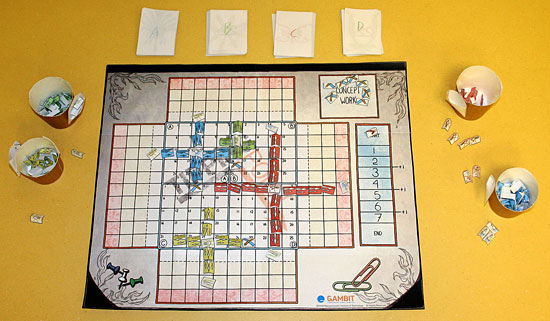 The result is a cooperative puzzle game for up to four players. Players assume the roles of Project Managers, and must work together to complete projects before they go too far past their deadline. The game is won by completing a set number of projects without letting any project fail.
The game is designed to be both a fun game and a useful training tool, teaching players how to manage multiple projects while emphasizing the importance of long-term planning. Projects are completed through a mix of Concept and Production work. “Concept Work” represents the planning and research done in the early phases of a project, while “Production Work” represents implementing the project, such as building a product. Each turn the players decide which project to work on and which type of work to be done. There must be a balance between Concept work and Production work: Production work is more useful in the short term, but Concept work is more useful in the long term.
Over the course of the game players can see how their previous choices affect the current state of the game, which helps them understand the benefits of long-term planning. Concept work done on early projects will have a positive impact on later projects, making them easier to manage. Production work makes it easier to finish a project immediately, but players who spend too much time on Production work will soon find their later projects uncontrollable.
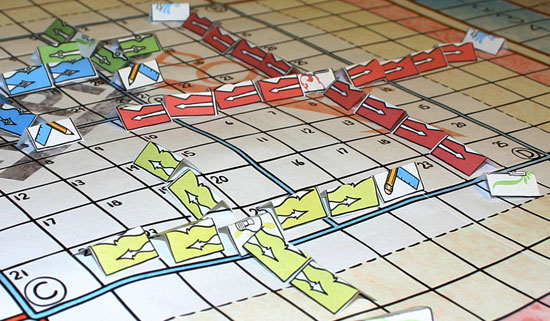 Tipping Point also demonstrates the problem of letting projects continue for too long. If they are not completed early on, projects will begin to negatively impact each other, creating a downward spiral that is difficult to reverse. The “Tipping Point” is the start of this spiral. If they want to succeed the players must work together to prevent the game from reaching this point.
The game is an engaging puzzle that requires players to think long-term and work together. If anyone’s project fails, everyone loses: players win or lose as a team, and many decisions in the game must be made by consensus. As the game progresses the number of simultaneous projects increases, forcing players to think strategically about when to complete and when to begin new projects. A hasty decision can quickly change several small projects into an enormous, convoluted amalgamation that is almost impossible to manage.
While fun on its own, Tipping Point is an excellent team builder and project management training tool. It is highly recommended for any organization where teamwork and long-term planning are core values.
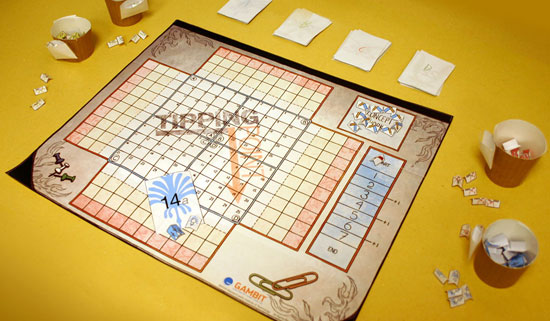 Tipping Point is now available at http://gambit.mit.edu/loadgame/tippingpoint.php – download it, grab some art supplies and some friends, give it a shot and let us know what you think!

February 25, 2009
1:25 pm
Want a behind-the-scenes look into the development of our “IGF Grand Prize finalist and XNA Community Games standout” game CarneyVale: Showtime? That’s just what programmer Bruce Chia and artist Desmond Wong provide in a featured postmortem article at Gamasutra that just went live.
Highlights of the piece include detailed lists of what went right and what went wrong during the game’s development, as well as an in-depth look into… The evils of HD?
When we were building the game, we made sure that it looked great and ran properly on our development machines, not realizing how much influence that would have on our production. Not planning for wide distribution of our game made it much less accessible to other languages, regions and screen setups.
Our team had an HDTV in our lab that we used for most of our initial prototypes, and all of our computers were capable of rendering at high resolutions.
This led us to work under the incorrect assumption that we were developing the game only for HD displays, and we lacked the foresight to support lower-resolution televisions.
In our zeal, we created so many assets that when we finally realized we should cater to lower resolutions, downsizing those assets was an insurmountable task.
For example, we had many lines of text that we’d rendered as image files with fancy effects. Although the Xbox Live Community Games reviewers did not reject our submission for this reason, many of them did complain that words were cut off and that some text was too small to read.
This was especially evident on CRT television screens that were less than 20″ in size. However, due to time constraints and the need to ship, we had to push the title to Xbox Live Community Games without catering to lower-resolution television sets.
D’oh! Check out the full postmortem for this and other stories.

February 18, 2009
11:54 am
It’s been a while since I’ve posted a links list here, and there’s been a ton of interesting stuff popping up lately. So, without further ado…
zomg important stuff
generally awesome stuff
- NYT: What Convergence? Why it’s taking so long to get the Web on our TVs.
- Agents in the Trades. Gotta find a copy of the Feb. 09 The Writer.
- HarperCollins’ new format: video books. Bwuh?
- Underland Press. Fascinating new micropublishing house specializing in the New Weird.
- In defense of the MFA. “The only people impressed by an MFA in writing are those who don’t write and never worked in publishing.” Ouch.
- Digital ghost towns. More awesomeness from the Tomorrow Museum.
- The business of webcomics. J. Jacques does it again.
- Q&A with Mike Carey. I love the bits on adaptation.
- The laws of the thriller. “When popular novelists, stung by critical disregard while contemptuous of it, reject literariness and describe themselves as storytellers, they may often be wrong in all but the barest mechanical sense, but they raise some useful general points: rather wholehearted pulp than earnestness; rather economy than “weight”; and rather winter in a canning factory in Narvik than John Grisham.”
- TIME: Content, once king, becomes a pauper. I prefer “once and future king”.
- Announcing BigIdeaAuthors.com. April 20 can’t arrive soon enough.
- Indigo’s Shortcovers initiative. Interesting: physical books + e-books + iPhone.
- Marvel’s motion comics, Vertigo’s $1 first issues and ‘literary’ OGNs. Fun year for comics ahead.
- Sarah Weinman on O’Reilly’s future of publishing conference. “We can dream of the future all we want, one where the reading experience is a marvel of social interaction and multiple communities and fresh ideas, and dreaming is good. But change is also slower and much faster than we can possibly anticipate – and in the end, experts and enthusiasts alike only know as much as what’s right in front of them, nothing more.”
- John Crowley on Giordano Bruno. RIP Giordano.
- BBC: Alien life may exist among us. Cats explained at last!
- Coraline fun facts. Sad truth: I still haven’t seen it yet.
- Theodora Goss on the humor of Lord Dunsany. “Life is real, life is earnest…”
- Seven reasons why
musicians anyone should use Twitter. Awesomesauce.
- How successful writers keep up their self-confidence. I’d add “not take classes from bad professors.”
- Gwenda Bond on Bones of Faerie. I smell a must-read.
- Tor.com on Bones of Faerie. “”Nothing has been seen or heard from Faerie since, but the world is filled with the deadly magic the War left behind: trees that seek out human blood, glowing stones that burn with cold fire, forests whose shadows can swallow a person whole.” Oh, hells yes.
- Uncle Warren on the $500 miniseries. He’s right: the game, it is a-changin’.
- Trackmate. Intriguing: “Trackmate is an open source initiative to create an inexpensive, do-it-yourself tangible tracking system.”
- Dmitri Orlov on social collapse. Grim. (From Bruce Sterling.)
- Starbucks announces instant coffee. Srsly, ‘Via’? Via what?
- Bruce Sterling: 2009 will be a year of panic. It already is.
- Bruce Sterling: 2009 when the 21st Century really begins. It already has.
- Q&A with Gregory Frost. What are you hardwired for?

February 13, 2009
7:58 am
We’re proud to announce that our Summer 2008 prototype game Picopoke has been named an IGF Mobile ‘Next Great Mobile Game’ Finalist! Here’s the IGF’s official press release:
The 2009 Independent Games Festival Mobile, an event that celebrates innovation in games for handheld devices, including mobile phones, Nintendo DS, PlayStation Portable (PSP), iPhone and iPod touch, has named the finalists for the competition’s “Next Great Mobile Game” category, presented by the IGF Mobile’s Platinum and Founding Sponsor NVIDIA. Oriented towards the entries that offer truly unique and groundbreaking mobile gaming concepts in at least prototype form, finalists will be asked to give a presentation and demonstration of their concept and game during the IGF Mobile ceremony held during the Game Developers Conference Mobile conference on March 24, with the winner to be voted on by the audience.
Finalists for this year’s competition include FastFoot Challenge, a multiplayer GPS action game where play takes place as a real world chase supported by mobile phones, Picopoke, an interpretive photo game integrated with Facebook that asks players to take photos to beat challenges, and Rhythm of War, a unique rhythm action title for Sony’s PSP.
This year’s IGF Mobile competition is supported by Platinum and Founding Sponsor NVIDIA – which is awarding “The Next Great Mobile Game” at this year’s awards, with finalists to be revealed soon, as well as Gold Sponsor and Best iPhone Game prize sponsor ngmoco.
The full list of finalists for the 2009 IGF Mobile “Next Great Mobile Game” competition are:
Depict (VillaVanilla) – iPhone
FastFoot Challenge (Urban Team) – J2ME
Picopoke (Singapore-MIT GAMBIT Game Lab) – Photo/Internet-capable Mobile Handsets
Rhythm of War (SME Dynamic Systems Ltd) – Sony PSP
Reflection (Team Reflection – University of Southern California) – Nintendo DS
As well as receiving $2,000 of the IGF Mobile’s $30,000 prize pool, the winner of the IGF Mobile’s “Next Great Mobile Game” will be given a spot in the IGF Mobile’s pavilion (adjoining the main IGF Pavilion) in which to demonstrate a playable version of their game, alongside the finalists of the main IGF Mobile competition. The pavilion is to be at the Game Developers Conference 2009 and is set to take place at the Moscone Center in San Francisco from March 23rd to 27th.
Picopoke was created by Kevin Driscoll (Product Owner), Yee Kar Kin (Scrummaster), Clara Rhee (Designer), Ang Yi Xin (Artist), Anindita Ningtyas (Artist), Munir Bin Hussin (Programmer), Pham Ngoc Hoang Viet (Programmer), Ong Yit Sin (QA Lead), Erik Sahlström (Audio Designer) and Pradashini Subramaniam (Additional Audio). Way to go, folks!

|


